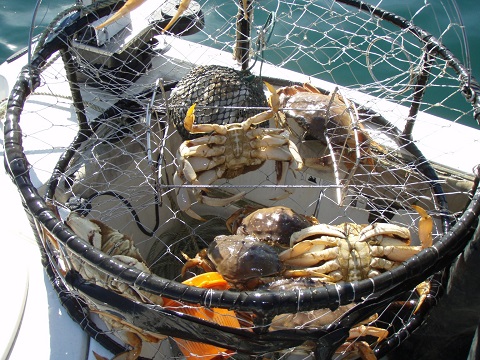
Report Date:
http://www.dfg.ca.gov/The last remaining area of the California coast will open to commercial Dungeness crab fishing. The area was previously closed due to elevated levels of domoic acid. The last closed area between Ten Mile River and Shelter Cove is scheduled to open on Jan. 16.
At the recommendation of the state Office of Environmental Health Hazard Assessment (OEHHA), California Department of Fish and Wildlife (CDFW) Director Charlton H. Bonham submitted to the Office of Administrative Law an emergency rulemaking to keep the commercial Dungeness crab fishery closed north of Point Reyes and to close the commercial rock crab fishery north of Pigeon Point. State and federal laws prohibit the commercial distribution of seafood products that contain domoic acid levels above the federal action level of 30 parts per million in the viscera. Because of this, on Nov. 8, OEHHA, in consultation with the California Department of Public Health (CDPH), recommended to CDFW to close or delay the start of the commercial Dungeness crab season north of Point Reyes and close the commercial rock crab fishery north of Pigeon Point. Since then, other areas of the California coast have opened to commercial Dungeness crab fishing as test results have come back below the action level. The recreational season for Dungeness crab opened on Nov. 5 under a warning to anglers not to eat the viscera of crab caught in the affected areas, but those health advisories have since been lifted in these same areas.
CDFW will continue to coordinate with CDPH and OEHHA to test domoic acid levels in rock crab along the coast to determine when the commercial rock crab fishery can safely be opened north of Pigeon Point, San Mateo County. Domoic acid is a potent neurotoxin that can accumulate in shellfish, other invertebrates and sometimes fish. It causes illness and sometimes death in a variety of birds and marine mammals that consume affected organisms. At low levels, domoic acid exposure can cause nausea, diarrhea and dizziness in humans. At higher levels, it can cause persistent short-term memory loss, seizures and can in some cases be fatal.
For more information:
Memo from Office of Environmental Health Hazard Assessment (1/11/2017)
wildlife.ca.gov/Fishing/Ocean/Health-Advisories
wildlife.ca.gov/crab
Report Date:
Regulations for California’s popular red abalone sport fishery have changed in 2017. Due to concerns about the declining population, the......
Report Date:
Question: When hunting waterfowl in California, how do hybrid ducks and geese count toward species limits? For example, the first duck......